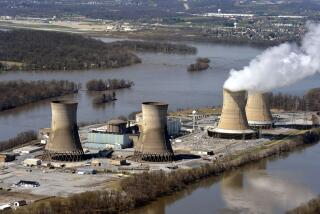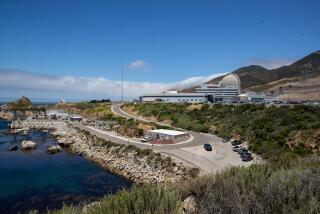Reactors Operated 7 Years at Risk : 3 U.S. Units Have Cut Power to Ease Meltdown Danger
WASHINGTON — Three government-owned nuclear reactors that produce plutonium for nuclear weapons operated for seven years under conditions in which an accident could have led to the melting of their fuel cores, officials of the General Accounting Office told a Senate committee Thursday.
The reactors, at the U.S. Energy Department’s nuclear facility at Savannah River, S.C., were ordered to reduce power by 20% last November and an additional 6% in December after studies showed that their emergency cooling systems might be inadequate in the event of an accident while operating at full power.
Keith O. Fultz, associate director of the GAO’s Resources, Community and Economic Development Division, told the Senate’s Government Operations Committee that the Energy Department’s L, K and P reactors had been operating at full power since 1979.
“If we had gotten into trouble,” committee Chairman John Glenn (D-Ohio) asked, “we would have had an uncontrolled meltdown at Savannah River?”
Identifies Risk
“That is the risk . . . if the emergency core cooling system is not adequate,” Fultz replied.
In addition to the questionable adequacy of the emergency cooling systems under full-power operation, GAO officials said there was suspicion last fall of a possible crack in the L-Reactor, and they questioned whether inspection techniques being used on the government-owned nuclear power plants are adequate.
“Last fall, during a maintenance shutdown of the L-Reactor, marks were identified that might have been cracks,” Fultz said. “Therefore, based on the criteria, about half of the marks identified were dye-tested to determine if they actually were cracks. No cracks were found, and the L-Reactor was restarted in December, 1986.”
Fultz said the DuPont Co., which operates the plant for the Energy Department, is still analyzing material scraped from the suspect area, but he questioned whether the visual inspection techniques used on the government reactors are adequate.
Test Results Limited
“Although the dye test used for the L-Reactor can identify cracks better than visual inspection,” he said, “it is limited because it cannot determine a crack’s depth--in other words, how close it is to breaking through the wall.”
The nation’s plutonium production reactors have come under increasing scrutiny since last year’s disastrous accident at the Soviet Union’s Chernobyl reactor in the Ukraine.
The U.S. reactor most like the Chernobyl plant, the Energy Department’s N-Reactor at Hanford, Wash., was closed late last year for an extended period of inspection, maintenance and modification. Consulting nuclear engineer Lou Roddis, who inspected the plant after the Chernobyl tragedy, Thursday called for the facility’s replacement.
Assistant Comptroller General J. Dexter Peach told the Senate panel that the plant will require $1.2 billion in modifications if it is to continue operating beyond the year 2000. The reactor has already exceeded its design lifetime.
Costly Renovation
Glenn said the testimony at the hearing suggested that the aging industry that produces nuclear materials for American weapons may indeed be facing renovation, modernization and environmental cleanup that will run into the tens of billions of dollars.
When the Hanford, Savannah River and Rocky Flats weapons facilities were constructed for the old Atomic Energy Commission, their cost totaled about $100 billion.
In addition to the N-Reactor at Hanford, and the three Savannah River units operating at reduced power, the Energy Department’s two other production reactors, both at Savannah River, are idle. The department’s R-Reactor has been shut down since 1964, and the C-Reactor has been out of operation since July, 1985, when cracks were found in its stainless steel tank wall.
Glenn, saying the problems with the facilities raise the specter of a “creeping Chernobyl,” is preparing to introduce legislation creating an independent organization to conduct safety oversight of the government-owned nuclear plants, much as the Nuclear Regulatory Commission oversees the commercial nuclear industry.
More to Read
Sign up for Essential California
The most important California stories and recommendations in your inbox every morning.
You may occasionally receive promotional content from the Los Angeles Times.










